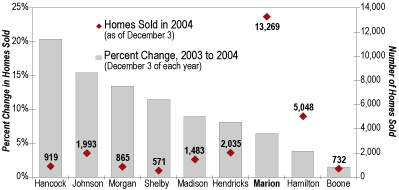Indianapolis
Kelley School of Business, Indiana University, Indianapolis
Recent performance of the Indianapolis economy (1) fell short of expectations, especially in terms of employment. During the twelve months before September 2004, total employment shrank 2.2 percent from 868,690 to 849,830. This sharply contrasts with the U.S. employment growth of 1.4 percent during the same period. As of September 2004, the local unemployment rate was 4.7 percent, which was less than the national rate of 5.1 percent (not seasonally adjusted).
There is reason to believe, though, that measurement of the local unemployment rate understates the impact of job loss on the Indianapolis economy. The unemployment rate is the percentage of the labor force who cannot find a job. A citizen is no longer counted as part of the labor force if he or she stops looking for a job. When local jobs are scarce and acquisition of new jobs requires an unexpected wait, many discouraged individuals stop searching altogether and statistically remove themselves from the labor force. During the twelve months before September 2004, the local labor force shrank by 20,200—from 912,000 to 891,800. Nationally, the labor force grew by 0.7 percent over the same period. If the size of the local labor force had remained at 912,000 individuals, adding 20,200 back to the rolls of the unemployed, the local unemployment rate for September 2004 would be adjusted upward to 6.8 percent.
Local retrenchment in employment was not concentrated in just one or two industries. For example, between the fourth quarters of 2002 and 2003, metropolitan Indianapolis lost 3,434 jobs in manufacturing, 1,181 jobs in retail trade, 918 jobs in wholesale trade, and 746 jobs in transportation and warehousing. Growth in finance and insurance generated only 280 jobs. The most pronounced job growth occurred in educational services and health care, with gains of 1,768 and 2,215 jobs, respectively. Given the high rate of new facility construction and slower growth in hiring at Eli Lilly, most job growth in health care is occurring in the services delivery area instead of bioscientific research and life science enterprise creation. Economic research has established advanced manufacturing, logistics, and life sciences as the leading sectors of long-term job growth in Indianapolis. Recent performance suggests that economic and employment takeoff has not yet occurred in these areas.
Income growth in Indianapolis has lagged national performance. Total wages earned by Indianapolis workers between the fourth quarter of 2002 and the fourth quarter of 2003 grew at an annual rate of 3.8 percent, from $8.1 billion to $8.4 billion. Over the same period, U.S. gross domestic product grew at a 6.1 percent annual rate. Simultaneous growth in wages and shrinkage in employment does imply an increase in productivity among individuals who had a job. This explains a weekly wage increase for the average Indianapolis worker of 3.0 percent, from $732 per week to $754 per week, over the same period. Weekly wages increased from $1,060 to $1,132 in manufacturing (6.8 percent), from $736 to $769 in health care (4.5 percent), and from $1,006 to $1,040 (3.4 percent) in finance and insurance.
Between 2002 and 2003, the number of residential building permits in Indianapolis fell 2.8 percent, but the total value of new residential construction increased 3.4 percent. Only 30.7 percent of these permits were in Marion County, and the value of new residential construction in Marion County fell 1.9 percent. This signals a disproportionately large share of new construction and commercial activity in surrounding counties.
Outlook for 2005
During 2005, job growth will be tepid at best. While continued recovery of the national economy will improve earnings for local companies and enable scattered job growth, evidence suggests that local employment bottlenecks will not break. This conclusion is reinforced by the hiring freeze at Eli Lilly, the bankruptcy of ATA Airlines, and intensified global competition in manufacturing. Incomes will grow, but probably at a rate half of that seen in the country at large.
In spite of higher interest rates, real estate will remain robust in communities surrounding Marion County as households act on their perception of better schools and lower crime farther from the city center. Recent data (2) show that, between December 3, 2003, and December 3, 2004, home sales increased by 7.5 percent in the MSA and broke the existing sales record set in 2003 (see Figure 1).
Figure 1
Metro Area Home Sales as of December 3, 2004

Residential and commercial development will continue in pockets around the downtown canal district as the local life science infrastructure expands. With housing demand centered around downtown and in suburban counties, growth in property values in Marion County townships will suffer.
Notes
- Data and forecasts refer to the entire Indianapolis Metropolitan Statistical Area (MSA), including Boone, Hamilton, Hancock, Hendricks, Johnson, Madison, Marion, Morgan, and Shelby counties. All data come from STATS Indiana at www.stats.indiana.edu, maintained by the Indiana Business Research Center at the Kelley School of Business.
- “Central Indiana Homes Sales Break Record Today,” F.C. Tucker Newsroom, 3 December 2004.
Also in this Issue…



